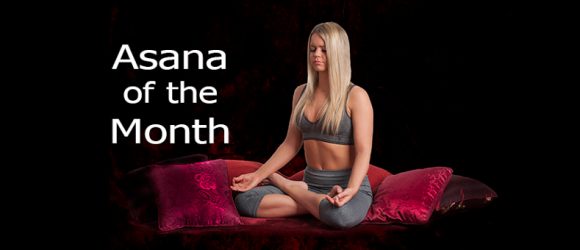Big Toe Bow Pose
- At January 04, 2022
- By Daniel
- In Asana, Education, Health & Wellness
 0
0
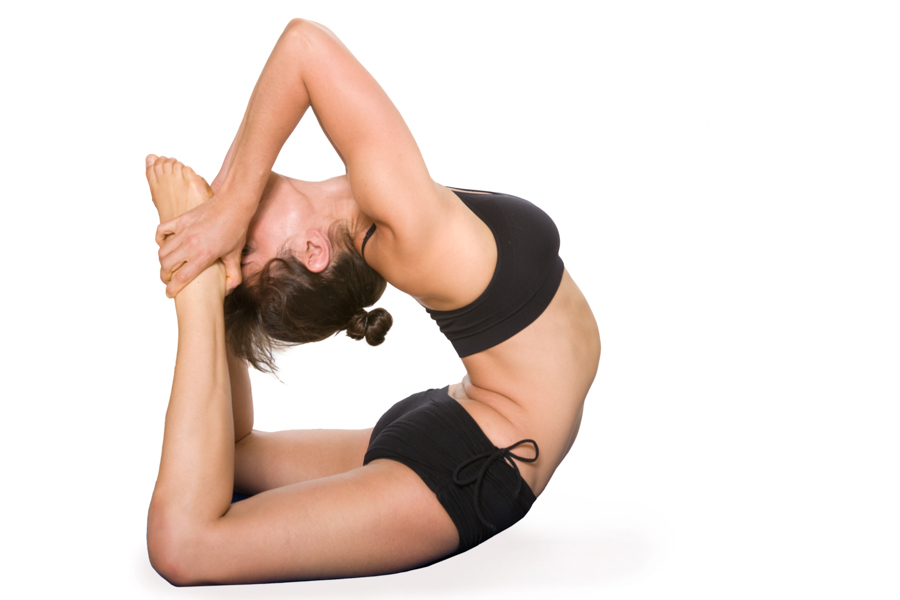
Big Toe Bow pose is a difficult back bending pose requiring more flexibility than Bow pose. It is a very challenging pose for people with limited flexibility especially with limited back flexibility.
English Name: Big Toe Bow Pose
Sanskrit Name: Padangustha Dhanurasana
Difficulty Level: 9
Start Position: Reclining on your belly
Instructions:
Step 1.
Placing your hands on the floor under your shoulders straighten into a back bend.
Step 2.
Bending both knees, stretch one arm overhead to grad both feet.
Step 3.
Stretch your other arm overhead grabbing your right foot with your right hand and your left foot with your left hand.
Step 4.
Bend your elbows and arch your head back touching your head to your feet.
Physical Benefits:
- Stretches ankles, calves, thighs, and spine
- Strengthens the spine and back muscles
- Opens up the chest
- Opens up the throat
- Aids digestion
Mental Benefits
- Stimulates the mind
- Reduces stress
- Relieves mild anxiety & depression
Contraindications:
- Pregnancy
- Knee, ankle, should or wrist injury
- Neck or back injury
Reclining Big-Toe Hold
- At May 04, 2021
- By Daniel
- In Asana, Yoga Benefits
 0
0
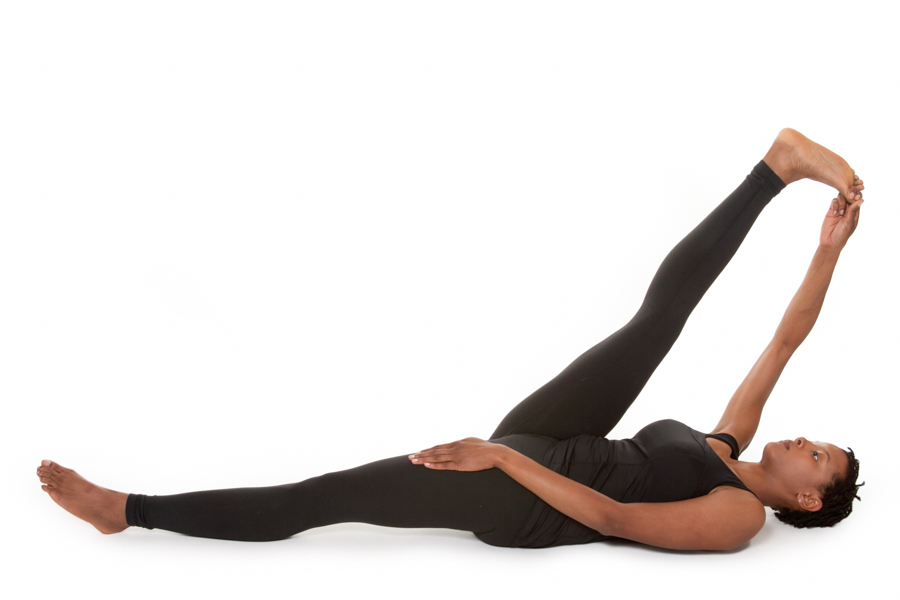 Reclining Big Toe Hold stretches your leg and arm muscles. This is a moderately difficult pose and can be challenging if you have limited arm and leg flexibility.
Reclining Big Toe Hold stretches your leg and arm muscles. This is a moderately difficult pose and can be challenging if you have limited arm and leg flexibility.
If you you do not have the flexibility to keep your leg and arm straight, use a strap. Place the soul of your foot against a strap and lift your leg, using one hand, keeping your arm and leg straight as high as comfortably possible. Your leg and arm flexibility will increase with time and practice.
Do not worry if using a strap is the only way you can do Reclining Big Toe Hold. There are many yoga poses that are beyond the limits of some people. I know from personal experience.
English Name: Reclining Big Toe Hold
Sanskrit Name: Supta Padangusthasana
Difficulty Level: 5
Start Position: Reclining on your back
Instructions:
Step 1.
Bend your right knee and curl your first two fingers of your right hand around your big toe.
Step 2.
Rest your left hand on your left leg. Straighten your right leg upward towards your head.
Step 3.
Hold the pose for several breathes or as long as it feels comfortable.
Step 4.
Release and repeat on the other side.
Physical Benefits:
- Stretches & maintains hip flexibility
- Stretches wrists, arms, and legs
- Opens up the chest
- Improves lung capacity
- Helps pituitary and thyroid function
- Reduces fatigue
Mental Benefits
- Reduces stress
- Calms the mind
- Relieves mild anxiety & depression
Contraindications:
- Pregnancy
- Low back or spine injury
- Hip or shoulder injury
- Hand injury
Asana Of The Month: Corpse Pose
- At August 04, 2020
- By Daniel
- In Books
 0
0
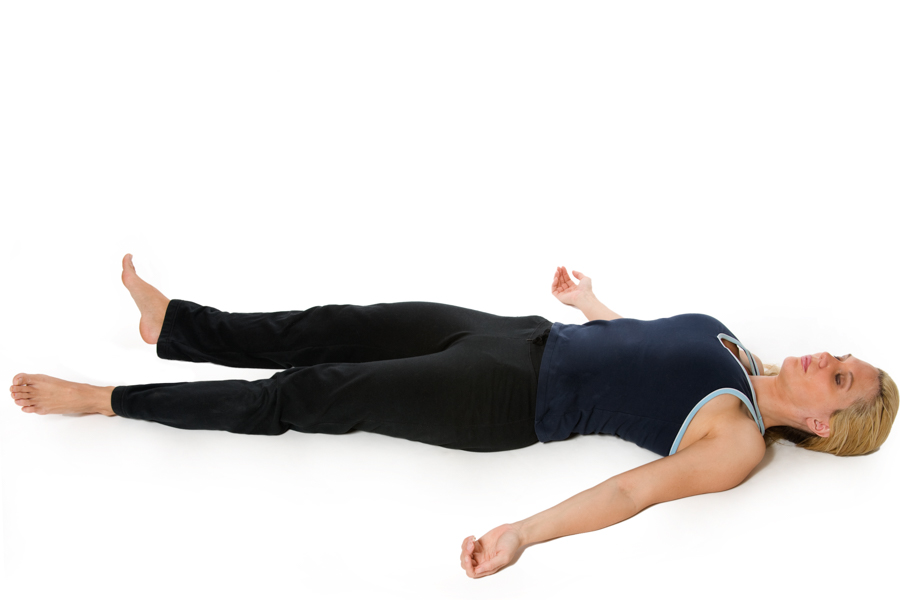 Corpse pose is a simple relation pose performed before and after a yoga practice. But you can use Corpse pose to relax any time you feel anxious or stressed. In vigorous yoga classes, like vinyasa and hot yoga, Corpse pose allows the body to cool down while calming the mind. Combine Corpse pose with Complete Yoga Breathing. You can also use Corpse pose to meditate and for yoga nidra.
Corpse pose is a simple relation pose performed before and after a yoga practice. But you can use Corpse pose to relax any time you feel anxious or stressed. In vigorous yoga classes, like vinyasa and hot yoga, Corpse pose allows the body to cool down while calming the mind. Combine Corpse pose with Complete Yoga Breathing. You can also use Corpse pose to meditate and for yoga nidra.
English Name: Corpse
Sanskrit Name: Savasana
Difficulty Level: 1
Start Position: Reclining on back
Instructions:
Step 1. Close your eyes
Step 2. Space your feet about a foot apart and let them fall apart.
Step 3. Place arms 12 to 15 inches from your side with your palms facing up.
Step 4. Relax and let go of your breath.
Physical Benefits:
- Reduce blood pressure
- reduce fatigue
- Relaxes the body
- Rejuvenates the body
Mental Benefits
- Reduces anxiety, stress and mild depression
- Calms and centers the mind
- Reduces insomnia
Contraindications:
- Lower back injury
- Spinal injury
- Pregnancy
Eight Angle (Astavakrasana)
- At May 05, 2020
- By Daniel
- In Asana, Yoga Benefits
 0
0
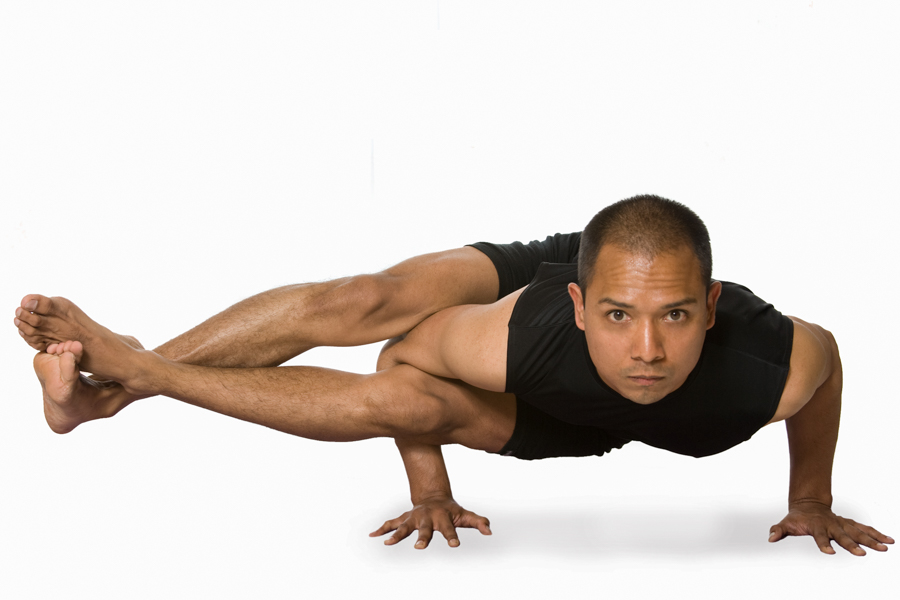 Frog pose takes Reclining Hero pose and turns it on its stomach rather than back. If you can do Reclining Hero you can do Frog. Frog adds extending your check like Cobra pose and grasping your feet with your hands. While Cobra and Reclining Hero have a difficulty level of 4, Frog increases the difficulty level to 6 giving your arms, back, and legs a good stretch.
Frog pose takes Reclining Hero pose and turns it on its stomach rather than back. If you can do Reclining Hero you can do Frog. Frog adds extending your check like Cobra pose and grasping your feet with your hands. While Cobra and Reclining Hero have a difficulty level of 4, Frog increases the difficulty level to 6 giving your arms, back, and legs a good stretch.
Like all hatha yoga asanas, always listen to you body to prevent injuries.
English Name: Eight Angle
Sanskrit Name: Astavakrasana
Difficulty Level: 7
Start Position: Easy Sitting
Instructions:
Step 1.
Hook your right shoulder under your right knee and extend your left leg forward on the floor.
Step 2.
Place both hands on the floor on either side of your left thigh.
Step 3.
Pressing into your hands, lift your buttocks off the floor while hooking your left ankle over your right ankle.
Step 4.
Bend your elbows, move your chest forward, extend your legs to the right, and gaze forward.
Step 5.
Hold the pose as long as it feels comfortable. Release. Return to Easy Sitting, and repeat on the other side
Physical Benefits:
- Stretches leg, arm, and shoulder muscles
- Opens up the chest
- Improves lung capacity
- Improves digestions
- Increase leg and arm strength
Mental Benefits
- Reduces stress
- Improves thinking
- Increases focus
Contraindications:
- Arm, wrist, shoulder, or leg injury
- Neck injury
- Carpel tunnel syndrome
Crow (bakasana)
- At April 07, 2020
- By Daniel
- In Asana, Yoga Benefits
 0
0
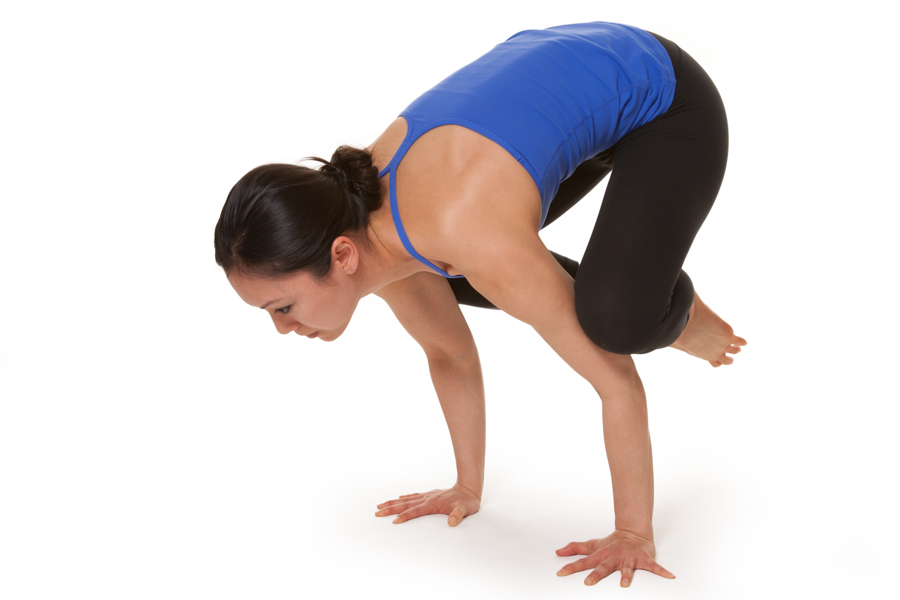 Crow, also known as Crane, pose is a popular balance pose. While it appears to be a simple pose it is challenging for most yoga practitioners. Crow pose requires concentration and focus more than strength. It is a matter of balance like balancing a spoon or fork on the tip of your finger. If you have wrist, arm, or shoulder pain or injury you should not do Crow pose. Like all hatha yoga asanas, always listen to you body to prevent injuries.
Crow, also known as Crane, pose is a popular balance pose. While it appears to be a simple pose it is challenging for most yoga practitioners. Crow pose requires concentration and focus more than strength. It is a matter of balance like balancing a spoon or fork on the tip of your finger. If you have wrist, arm, or shoulder pain or injury you should not do Crow pose. Like all hatha yoga asanas, always listen to you body to prevent injuries.
English Name: Crow (also known as Crane)
Sanskrit Name: Bakasana
Difficulty Level: 5
Start Position: Garland I
Instructions:
Step 1.
Walk you hands in from of your feet and rise up on tiptoes.
Step 2.
Press your knees into your upper arms and lean forward to balance on your hands.
Step 3.
Straighten your arms.
Step 4.
Hold the pose for 4 or 5 breaths or as long as it feels comfortable.
Physical Benefits:
- Improves balance
- Opens up hips and back
- Strengthens abdominal muscles
- Strengthens arms and wrists
- Improves digestion
- Stretches the wrists
Mental Benefits
- Improves concentration
- Increases focus
Contraindications:
- Wrist or shoulder injury
- Carpel tunnel syndrome
- Pregnancy
Lotus (Padmasana)
- At March 16, 2020
- By Daniel
- In Asana, Yoga Benefits
 0
0
 No other pose is more closely associated with hatha yoga than Lotus pose (padmasana). Lotus is what hatha yoga is all about. Asana prepares the body to sit in Lotus for hours of meditation. Many Westerners associate asana with a physical workout to tone the body. Astanga and power yoga are just another way of working up a sweat and staying in shape. Its nothing more than a work-out for the body.
No other pose is more closely associated with hatha yoga than Lotus pose (padmasana). Lotus is what hatha yoga is all about. Asana prepares the body to sit in Lotus for hours of meditation. Many Westerners associate asana with a physical workout to tone the body. Astanga and power yoga are just another way of working up a sweat and staying in shape. Its nothing more than a work-out for the body.
Yoga is not about obtaining firm abs. It is about obtaining a higher consciousness on the road to enlightenment (samadhi)- the eight limb of yoga.
Lotus can be too extreme for people with limited flexibility. Men usually find it more difficult to sit in Lotus than women. With practice, most men and women can can increase their flexibility and sit in Lotus pose. But, if it doesn’t happen do not dwell on it. You are not alone. The best I’ve ever achieved was half Lotus.
English Name: Lotus
Sanskrit Name: Padmasana
Difficulty Level: 3
Start Position: Staff
Instructions:
Step 1.
Bend your right knee, rotating from the hip, and place your right foot on your left thigh as close to your abdomen as possible.
Step 2.
Rotate your left hip and bend your left leg placing your left foot on your right thigh as close to your abdomen as possible.
Step 3.
Both knees should contact the floor. Remain in the pose as long as it feels comfortable.
Physical Benefits:
- Opens up the hips
- Improves knee flexibility
- Lubricates knee joint
- Relieve or prevent arthritis
- Tones abdominal muscles
- Improves digestion
- Tones back and shoulder muscles
Mental Benefits
- Focuses the mind
- Reduces stress
- Reduces anxiety
- Reduces mild depression
Contraindications:
- Low back, hip, knee, or ankle injury
Gentle Variation – Half Lotus

Standing Wide Leg Forward Bend II (Prasarita Padottanasana II)
- At March 14, 2020
- By Daniel
- In Asana, Yoga Benefits
 0
0
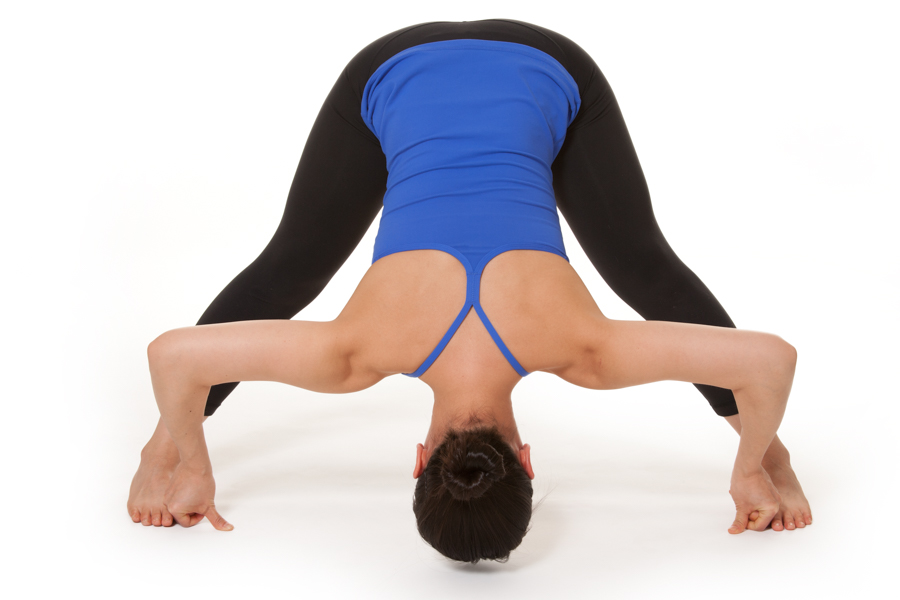 All Standing Forward Bends improves and maintains leg and back flexibility. For some people, wide leg forward bends put less stress on their backs and legs than straight leg forward bends. All forward bends provide the same physical and mental health benefits.
All Standing Forward Bends improves and maintains leg and back flexibility. For some people, wide leg forward bends put less stress on their backs and legs than straight leg forward bends. All forward bends provide the same physical and mental health benefits.
Use caution if you have glaucoma or a family history of high blood pressure. A research study found yoga poses where the head is lower than the heart may increase eye pressure. One way to reduce the risk is by limiting your time in these poses.
English Name: Standing Wide Leg Forward Bend II
Sanskrit Name: Prasarita Padottanasana II
Difficulty Level: 4
Start Position: Mountain
Instructions:
Step 1.
Step or jump your feet about 3 feet apart or a comfortable distance keeping your feet parallel to each other.
Step 2.
Bend (fold) forward from your hips maintaining a straight back and tilting your sit bones upward.
Step 3.
Curl the first two fingers on each hand around your big toes. If possible, rest the crown of your head on the floor.
Step 4.
Remain in the pose as long as it feels comfortable. Return to Mountain pose.
Physical Benefits:
- Improves and maintains ankle, knee, thigh and low back strength
- Tones abdomen
- Stretches wrists, arms, hamstrings, calves
- Reduces minor back pain or discomfort
- Lowers blood pressure
- Reduce headache pain
- Open sinuses
- Improves digestions
Mental Benefits
- Reduces stress
- Improves thinking
- Increases focus
- Relieves mild anxiety & depression
Contraindications:
- Low back or wrist injury
- High Blood Pressure
- Glaucoma
Standing Wide Leg Forward Bend I (Prasarita Padottanasana I)
- At March 12, 2020
- By Daniel
- In Asana, Yoga Benefits
 0
0
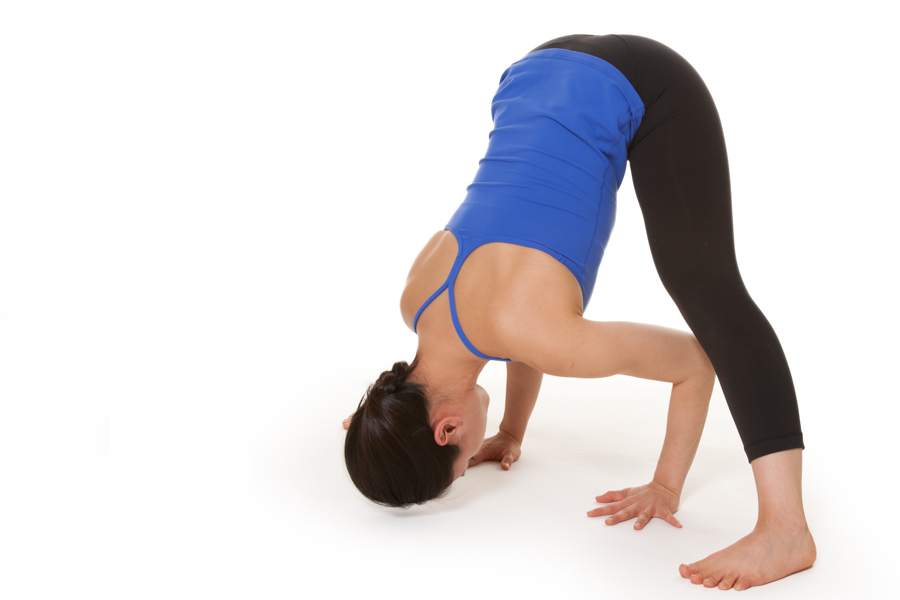 Standing Forward Bends improves and maintains leg and back flexibility. Use caution if you have glaucoma or a family history of high blood pressure. A research study found yoga poses where the head is lower than the heart may increase eye pressure. One way to reduce the risk is by limiting your time in these poses.
Standing Forward Bends improves and maintains leg and back flexibility. Use caution if you have glaucoma or a family history of high blood pressure. A research study found yoga poses where the head is lower than the heart may increase eye pressure. One way to reduce the risk is by limiting your time in these poses.
English Name: Standing Wide Leg Forward Bend I
Sanskrit Name: Prasarita Padottanasana I
Difficulty Level: 4
Start Position: Mountain
Instructions:
Step 1.
Step or jump your feet about 3 feet apart or a comfortable distance.
Step 2.
Bend (fold) forward from your hips maintaining a straight back and tilting your sit bones upward.
Step 3.
Place both hands on the floor energizing your hands and fingers, and keeping your hands parallel with your feet.
Step 4. Rest the crown of your head on the floor, and remain in the pose as long as it feels comfortable. Return to Mountain pose.
Physical Benefits:
- Improves and maintains ankle, knee, thigh and low back strength
- Tones abdomen
- Stretches wrists, arms, hamstrings, calves
- Reduces minor back pain or discomfort
- Lowers blood pressure
- Reduce headache pain
- Open sinuses
- Improves digestions
Mental Benefits
- Reduces stress
- Improves thinking
- Increases focus
- Relieves mild anxiety & depression
Contraindications:
- Low back or wrist injury
- High Blood Pressure
- Glaucoma
Half Cobra (Ardha Bhujangasana)
- At March 10, 2020
- By Daniel
- In Asana, Yoga Benefits
 0
0
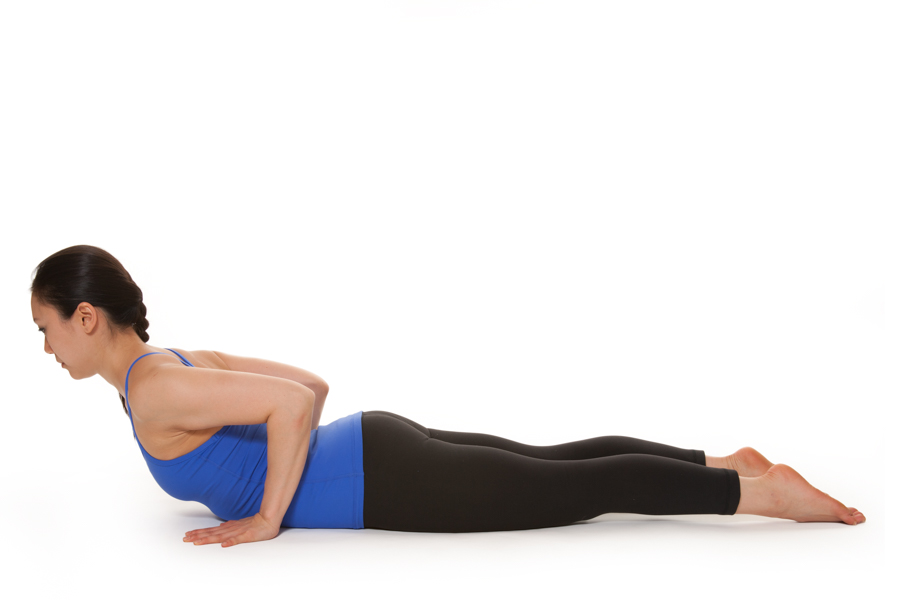 Half Cobra has the same physical and mental benefits of Cobra Pose. If you are new to yoga and have limited flexibility, you can do Half Cobra instead of Cobra pose in Sun Salutations and other yoga routines until you develop flexibility to do full Cobra pose.
Half Cobra has the same physical and mental benefits of Cobra Pose. If you are new to yoga and have limited flexibility, you can do Half Cobra instead of Cobra pose in Sun Salutations and other yoga routines until you develop flexibility to do full Cobra pose.
English Name: Half Cobra
Sanskrit Name: Bhujangasana
Difficulty Level: 4
Start Position: Lying on belly
Instructions:
Step 1.
Position your hands alongside your ribs.
Step 2.
Inhale, slinging your chest forward and slightly up, keeping your belly on the floor.
Step 3.
Extend through the crown of your head and keep your shoulders drawn back. Gaze at the floor.
Step 4.
Hold for several breaths, or as long as is comfortable, and exhale back to start position. Repeat if desired.
Physical Benefits:
- Improves circulation
- Improves posture
- Improves digestion
- Opens the chest and shoulders
- Lengthens the spine
- Increased spinal flexibility
- Strengthens lower back
- Strengthens shoulders
Mental Benefits
- Reduces stress
- Improves focus
- Reduces mild depression
- Reduces anxiety
Contraindications:
- Pregnancy
- High blood pressure
- Severe spinal injury
- Severe neck injury
Mountain Pose (Tadasana)
- At March 10, 2020
- By Daniel
- In Asana, Yoga Benefits
 0
0
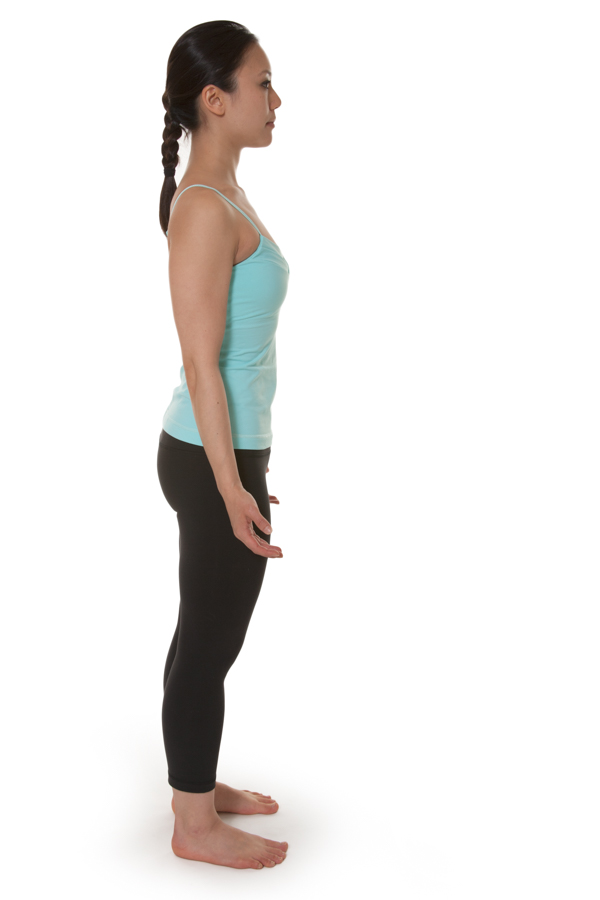 Mountain Pose is the start position for many standing poses and salutations like the Sun Salutation. Like Staff pose, it looks Mountain pose is a simple, straight forward pose. Mountain pose is about balance and focus. Place more weight on leg verses the other and you can loose your balance and topple over. The legs and spine are straight. The knees should not be bent. The arms are straight, not bent at the elbow or wrist. The head and neck are straight, not tilted to one side or front to back. While Mountain pose has a difficulty level of 1 out of 10, there is more to the pose than meets the eye.
Mountain Pose is the start position for many standing poses and salutations like the Sun Salutation. Like Staff pose, it looks Mountain pose is a simple, straight forward pose. Mountain pose is about balance and focus. Place more weight on leg verses the other and you can loose your balance and topple over. The legs and spine are straight. The knees should not be bent. The arms are straight, not bent at the elbow or wrist. The head and neck are straight, not tilted to one side or front to back. While Mountain pose has a difficulty level of 1 out of 10, there is more to the pose than meets the eye.
English Name: Mountain
Sanskrit Name: Tadasana
Difficulty Level: 1
Start Position: Standing Erect
Instructions:
Step 1. Stand with feet hip-width apart. Relax your shoulders and relax your arms along side your body.
Physical Benefits
- Aligns spine
- Opens the chest
- Improves posture
- Strengthens ankles
- Strengthens knees
- Strengthens thighs
- Strengthens arches
Mental Benefits
- Improved focus
- Reduces mild anxiety
Contraindications
- Wrist injury
- Knee or ankle pain

